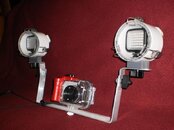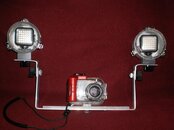Guba
Contributor
This is my solution for a tray for an intova camera. I shoot an IC14 and use it for both stills and video. The tray, like others, is aluminum bar, and I added a strip of plastic to provide a non-slip base. The two DIY light housings each hold a commercial 36 LED array and I placed them on sectioned arms that allow full up-and-down as well as horizontal movement. Simple, cheap, and versatile. The arms are also capable of being re-positioned so that the lights are lower, or toward the center, or even mixed for whatever shot is needed.








